PICK OF THE MONTH
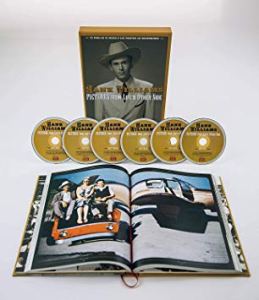 Hank Williams
Hank Williams
Pictures from Life’s Other Side: The Man and His Music in Rare Photos and Recordings (book + 6 discs)
BMG
No cat. no.
In 1951, Hank Williams had his own radio show on WSM, home of the Grand Ole Opry. Sponsored by Mother’s Best Flour, each show lasted 15 minutes, and some were performed live on the air, but because of his punishing tour schedule many of them had to be prerecorded onto acetate discs. Those discs were lost for decades, and were only saved for posterity because someone stopped them from being hauled to a dumpster. The complete transcriptions have been released before, in a 15-disc set packed into a box shaped like an antique radio, but that collection is long out of print. (If you’re interested, you can find used copies that will run you several hundred dollars.) This box is a bit more wieldy: six discs of selections from the Mother’s Best shows, packaged inside the case binding of a large book of photographs, which itself comes inside a sturdy box sleeve. The photos are beautifully reproduced and presented with minimal text; the music is incredibly well preserved (it was newly remastered for this release), and will remind anyone who listens exactly why Hank Williams is still the colossus that bestrides country music: that powerful, reedy voice; those uniquely incisive and creative lyrics; that tight, swinging band. And it has to be said that Williams’ physical beauty was always part of the package, and only enhances the attractiveness of this release: no one ever looked cooler than Hank Williams did when he stooped into the mic over his Martin D-28, his face all sharp angles, his Stetson hat shading a sly grin. Leaf through the pictures while you’re listening to him sing “Cold Cold Heart” and just see if every hair on your neck doesn’t stand on end.
CLASSICAL
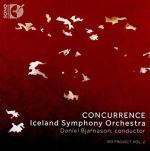 Various Composers
Various Composers
Concurrence (CD + Blu-Ray disc)
Iceland Symphony Orchestra / Daníel Bjarnason
Sono Luminus (dist. Naxos)
DSL-92237
This is the second installment in an ongoing series of recordings dedicted to “bringing the orchestral sound world of Icelandic composers to the ears of the world,” in the words of the Iceland Symphony Orchestra’s Principal Guest Conductor Daníel Bjarnason. Four compositions are featured: the majestic and sometimes downright eerie Metacosmos by Anna Thorvaldsdóttir; Haukur Tómasson’s second piano concerto (featuring the outstanding pianist Vikingur Ólafsson); Oceans by Maria Huld Markan Sigfúsdóttir; and Páll Ragnar Pálssom’s Quake (featuring cello soloist Sæunn Thorsteinsdóttir). Because the program’s focus is on composers from a very specific place, one is tempted to listen for stylistic commonalities–but good luck with that. Each work is fairly modernist, but beyond that there isn’t much that unites them sonically. Instead, each composer offers a different musical vision, some more programmatic and others more impressionistic, some more tonal and some less so. All are very much worth hearing, and the playing is consistently excellent.
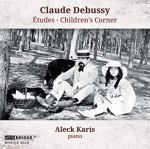 Claude Debussy
Claude Debussy
Etudes; Children’s Corner
Aleck Karis
Bridge (dist. Albany)
9529
There’s something a little bit curious about Claude Debussy–widely seen as the pioneer of musical impressionism–writing a set of études for the piano. How does a composer so dedicated to sonic mystery and abstraction write music designed for the cultivation of technique? The answer: idiosyncratically. Notice, for example, the almost puckish juxtaposition of arpeggios and sudden flights of melismatic fancy in the first étude of the first book. Elsewhere, though, the casual listener might be forgiven for failing to recognize these pieces as études at all. The six-movement Children’s Corner, by contrast, is a pure delight, a reflection of Debussy’s uncomplicated devotion to his daughter, for whom these pieces were written. In the final one, “Golliwog’s Cake Walk,” Debussy’s sense of humor is fully unleashed. Aleck Karis is a magnificent advocate for these works.
 Franz Joseph Haydn
Franz Joseph Haydn
Haydn Piano Sonatas, Vol. 2
John O’Conor
Steinway & Sons (dist. Naxos)
30110
From the ethereal and strange impressionism of Debussy to the strict (if always melodically winning) formalism of Haydn; unless you want sonic whiplash, I wouldn’t recommend listening to the previous entry and this one back-to-back. John O’Conor is a champion of Haydn’s piano sonatas, which he believes are underappreciated. He makes a strong argument for them on his second album in the series, playing sonatas 48, 50, 54, 59, and 60 with both fluid grace and emotional insight, bringing out both the structural ingenuity that is always front and center and and the humor that always lurks just below the surface in Haydn’s work. The recorded sound is perfect; intimate but not crowded, rich without being too resonant. Highly recommended to all classical collections.
 Johann Sebastian Bach; Johann Bernard Bach; Johann Ludwig Bach
Johann Sebastian Bach; Johann Bernard Bach; Johann Ludwig Bach
Complete Ouvertures for Orchestra (2 discs)
Concerto Italiano / Rinaldo Allesandrini
Naïve (dist. Naxos)
OP 30578
Rick’s Pick
 Johann Bernhard Bach
Johann Bernhard Bach
Orchestral Suites
Thüringer Bach Collegium
Audite
97.770
Rick’s Pick
J.S. Bach’s orchestral suites are among his most popular and frequently-recorded works, so it would be easy to overlook both of these new releases, one of which juxtaposes J.S. Bach’s suites with those of two of his cousins, and one of which focuses explicitly on one of those cousins, Johann Bernhard. The recording by Concerto Italiano puts two of J.S. Bach’s suites on each disc, in each case sandwiching one of his cousins’ suites between them: disc 1 features Johann Bernhard Bach’s E minor overture between J.S.’s first and second orchestral suites, and disc 2 places Johann Ludwig Bach’s G major suite between J.S. Bach’s third and fourth. The recording by the Thüringer Bach Collegium (a small chamber orchestra that functions without a conductor, though violin soloist Gernot Sußmuth is also credited as “ensemble leader”) focuses on four orchestral suites by Johann Bernhard Bach, none of which duplicates the work on the previous recording. J.B. wrote in the then-fashionable goût mixte style, blending elements of Italian and French structure in his pieces, and although these suites are rarely recorded today they were highly praised during his lifetime. Both of these releases are both historically significant and musically delightful.
 Ludovici Einaudi
Ludovici Einaudi
Seven Days Walking (reissue; 7 discs)
Decca
4818166
Ludovici Einaudi is perhaps best known as a soundtrack composer, having scored numerous Italian films and contributed music to the soundtracks of popular movies like Black Swan and I’m Still Here. But he has also written quite a bit of concert music, and this massive project was inspired by his daily walks in the Italian Alps. Over the course of 2019 he released seven individual albums, each containing quiet and contemplative music for piano, cello, and violin; now all seven are available in a single box set. Working my way through all of these recordings, I noticed something interesting: there would be moments when I’d think “I don’t know, I think this music is a bit too simple to be interesting”–and then something would happen musically that would catch and hold my attention. It was usually something subtle: a gentle harmonic mutation, or a quiet but sudden divergence from a well-established ostinato. But then I’d find that I was listening with new appreciation. Libraries that collect in contemporary music or in pop-classical crossover should definitely give this set strong consideration.
 Henry Aldrich
Henry Aldrich
Sacred Choral Music
Cathedral Singers of Christ Church, Oxford; The Restoration Consort; David Bannister / James Morley Potter
Convivium (dist. Naxos)
CR 052
 Various Composers
Various Composers
The Tudor Choir Book
Croydon Minster Choir of Whitgift School; English Cornett & Sackbutt Ensemble / Ronny Krippner
Convivium (dist. Naxos)
CR 042
Henry Aldrich was an Oxford-based composer in the late 17th century, eventually serving as Dean of Christ Church (after his Catholic predecessor was forced to flee the city during escalations in religious tension) and then as vice-chancellor of the university itself. During his career he wrote vocal music for use in Christ Church Cathedral, as well as vocal and instrumental music to accompany the annual Oxford Act in the Sheldonian Theatre. Although this album is titled Sacred Choral Music, it actually features a variety of works for choir, solo voice, and string consort. All of it is wonderful, as are the performances. Another collection of early English vocal music from the same label is The Tudor Choir Book, which offers choral works by 16th-century English composers both familiar (Thomas Tallis, Peter Philips) and less so (Adrian Batten, Nathaniel Giles), interspersed with instrumental music for sackbutts and cornets by Italian composers of the period. Here again we have a combination of liturgical and devotional music, including Tallis’s frequently-recorded “Why Fum’th In Sight” and Adrian Batten’s rarely-heard Short Communion Service. These are performed by the Croydon Minster Choir of Whitgift School, whose boy trebles are sometimes a bit shrill but otherwise sound very fine. Both recordings are recommended to all early music collections.
 Tessa Lark & Michael Thurber
Tessa Lark & Michael Thurber
Invention (digital only)
Self-released
No cat. no.
Rick’s Pick
Violinist Tessa Lark and contrabassist Michael Thurber make an unusual duo, but if you need to be convinced that it’s an instrumental combination that works, just check out this delightful album. On it, the pair juxtapose selections from J.S. Bach’s Two-part Inventions with pieces that they either have written themselves or adapted from traditional sources (the latter seems to be the case with “Wooden Soldier,” which sounds like a set of unidentified Irish fiddle tunes). The original compositions, which are written in a variety of styles, contrast nicely with the foursquare counterpoint of the Bach inventions–and the inventions themselves (which are more commonly played on the keyboard) sound surprisingly rich and full in these duo arrangements. This is a wonderful album overall.
JAZZ
 Ken Fowser
Ken Fowser
Morning Light
Posi-Tone
PR8204
Rick’s Pick
I’ve been watching tenor saxophonist Ken Fowser’s career with great interest over the past few years, and continue to be deeply impressed by his work. For his latest album he has put together a classic tenor-and-trumpet quintet lineup (sharing the front line with trumpeter/flugelhorn player Josh Bruneau) to deliver an all-originals program that draws deeply on the hard-bop tradition that has been always been Fowser’s lodestar. If you’re a fan of 1960’s Blue Note recordings by the likes of Wayne Shorter and Joe Henderson, then you’re sure to enjoy this one. Which is not to say that Fowser’s playing is derivative; I’d say it’s respectful, while still forging his own stylistic path. There’s a bit more Latin flavor on this album, highlights including the nimbly bouncing “This That & the Other Thing” and the achingly sweet “Without Saying.” Also worth noting is the gently but powerfully swinging “Firefly.” Honestly, though, there’s not a weak track anywhere on the program. For all libraries.
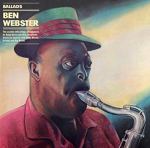 Ben Webster
Ben Webster
Ballads (reissue)
State of Art (dist. MVD)
81264
 Ben Webster
Ben Webster
The Soul of Ben Webster (expanded reissue)
Matchball (dist. MVD)
48023
Here are two somewhat confusing but still deeply enjoyable Ben Webster reissues, both bringing back to market releases that originally came out in the 1950s. Hold onto your porkpie hat while I try to explain: Ballads is a one-CD reissue of a two-LP set that was originally released in the 1970s, but which itself was a reissue of two 1950s LPs: Music for Loving and Music with Feeling. Due to time constraints, the CD version lacks two tracks from the original two-LP reissue. The Soul of Ben Webster draws on the same period and duplicates a few tracks on The Soul of Ben Webster, but also includes some wonderful uptempo material — plus the two tracks that are missing from the Ballads re-reissue. So here’s the thing: yes, the pedigree of these releases is confusing. But the music isn’t. Whether Webster is crooning or burning, his tone remains the thing of wonder that it was throughout his career, and the Norman Granz-produced sessions included on these albums are beautifully recorded and feature such stellar sidemen as Teddy Wilson, Ray Brown, Milt Hinton, and Art Farmer.
 Jonathan Ng
Jonathan Ng
The Sphynx (EP, digital only)
Self-released
No cat. no.
Rick’s Pick
I don’t often review digital-only releases, and I almost never review EPs, especially in the jazz genre. But this one, the latest release from violinist Jonathan Ng, is so much fun that I just had to make an exception. Apart from its length and format it has another thing going against it: unless my ears are greatly mistaken, the music is all recorded in mono and with production techniques that make it sound like a very skillfully remastered acetate 78, which seems unnecessarily gimmicky to me. Still, though: Ng and his sextet play vintage swing and hot jazz with such infectious glee and off-hand virtuosity that it’s impossible not to be caught up in it. His website lists a bunch of previous recordings that I’ve never heard of before, so I’m going back to dig into his catalog now. Highly recommended.
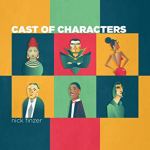 Nick Finzer
Nick Finzer
Cast of Characters
Outside in Music
OiM 2000
I confess that I approached this album with some trepidation. The program looked awfully… conceptual to me. But I’ve been a fan of trombonist Nick Finzer for a while, so I decided to give it a shot, and I’m very glad I did. The operant concept here is indicated by the album’s title: the tunes are arranged in mini-suites that deal collectively with the idea of musical influence. With clusters of tunes that are given titles like “Brutus (the Contemporary),” “A Duke,” and “The Weatherman,” Finzer and his sextet explore the tension between musical self-determination and the veneration of one’s predecessors–and also, not incidentally I think, the tension between tight and careful composition and unfettered self-expression. There is a constant push and pull between those two approaches, resulting in some truly thrilling music-making as beautifully orchestrated ensemble passages segue unpredictably into freestyle blowing and back again. This album is conceptually impressive, but also genuinely enjoyable.
 Benny Benack III
Benny Benack III
A Lot of Livin’ to Do (digital & LP only)
BB3 Productions
01242020
Rick’s Pick
I’ve always liked Postmodern Jukebox more in theory than in practice, but I have to say that the sophomore album by that group’s frontman is one of the funnest, sweetest, and most infectiously swinging jazz releases I’ve heard so far this year. With a voice that reminds me of John Pizzarelli at his best, and an equal facility as a songwriter and a song interpreter–not to mention considerable trumpet chops–Benny Benack III won my heart from the first track of this album. He then secured his hold on me with a Latin-jazz arrangement of the Mr. Rodgers song “Won’t You Be My Neighbor.” (“It’s You I Like” makes an appearance on the program as well). His original tunes are just as good as the pop and jazz standards he selected, and every performance is a joy. And that’s Christian McBride on bass, people. For all libraries.
 Bobby Previte; Jamie Saft; Nels Cline
Bobby Previte; Jamie Saft; Nels Cline
Music from the Early 21st Century
RareNoise
RNR115
Let’s finish out this month’s Jazz section with a palate-cleanser: a blast of brash, exploratory, alternately skronky and bluesy postmodern music from three genuine avant-jazz legends: drummer Bobby Previte, keyboardist Jamie Saft, and guitarist Nels Cline. Recorded live while on tour in early 2019, the music is mostly improvised, though there are moments when you would guess that it had been composed and carefully arranged. Saft spends most of his time on a Hammond B3 organ, which brings a disconcertingly familiar and even old-fashioned sound into a mix that is otherwise crammed with weird and futuristic noise (mostly courtesy of Cline, whose tonal palette is effectively without boundaries). Fans of downtown mainstays Massacre, Praxis, and Material (especially the albums featuring Bernie Worrell) will find much to love here, as will anyone who is coming to the end of a frustrating week and just needs her or his sinuses cleared. Turn it up and brace yourself.
FOLK/COUNTRY
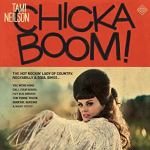 Tami Neilson
Tami Neilson
Chickaboom!
Outside Music (dist. Redeye)
CD-OUTS-9130
Retro-country-rocker Tami Neilson grew up playing in a family band in her native Canada, though her solo career really took after she relocated to New Zealand. But for her latest album she felt the pull of family again, and invited her brother Jay to come and play guitar and bass for the sessions. The result is a bristling if all-too-brief set of original songs that draw on country, rockabilly, R&B and blues traditions in roughly equal measure, all of them showcases for her powerhouse of a voice. Some of the songs don’t fit any existing genre at all; “Queenie, Queenie” sounds like a nursery rhyme written by a retired madame; “You Were Mine” sounds like a Patsy Cline song being covered by Nina Simone. But genre boundaries are for suckers, and each one of these songs is a slightly different kind of revelation. The Mavis Staples tribute is both sweet and fiery. Recommended.
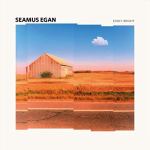 Seamus Egan
Seamus Egan
Early Bright (digital only)
THL
THL0003
Rick’s Pick
Composer, producer, and multi-instrumentalist extraordinaire Seamus Egan seems somehow to break new music ground with every release–and given that his recording career began 35 years ago, when he was 16, this means that he’s plowed a lot of musical soil. His latest album–and his first solo effort in 23 years–finds him in yet another new musical field, bringing his seemingly bottomless instrumental chops and his impressive compositional skills to bear on a set of tunes that draw on Irish tradition without staying bound by it. The title track is especially Celtic-sounding, but it segues into the less genre-specific “6 Then 5,” a track that could have been written by Penguin Cafe Orchestra if the Penguins weren’t so muzakky. The program proceeds accordingly, offering a kaleidoscopic array of tunes that offer layer upon layer of virtuosic playing and melodic inspiration. For all libraries.
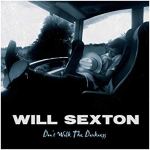 Will Sexton
Will Sexton
Don’t Walk the Darkness
Big Legal Mess (dist. Fat Possum)
BLM0573
Sexton comes from Austin by way of Memphis, and on his latest album he’s backed up by the New Orleans-based Iguanas. So if you hear a certain greasiness in his sound, well, he comes by it honestly. And like all the best musicians from all three of those cities, he makes music characterized simultaneously by looseness and tightness: a soft, almost casual approach to rhythm and to singing that nevertheless always stays firmly in the pocket. Songs like “Only Forever” and “Witness” draw deeply on traditions of Memphis soul (listen to those wonderfully subtle horn charts on the latter tune), while a strong whiff of outlaw Texas country wafts across everything like smoke from a mesquite campfire.
ROCK/POP
 Pulse Emitter
Pulse Emitter
Swirlings (LP & digital only)
Hausu Mountain (dist. Redeye)
HAUSMO92
Daryl Groetsch creates electronic music under the name Pulse Emitter, making music that straddles the increasingly fuzzy line between classical music and experimental rock. Not that his music has anything to do with “Rock,” per se–on this most recent release there are beats, more or less, and occasionally recognizable melodies, but mostly there are pulses, burbles, waves, clouds, chirps, and sighs. Listen closely and you may notice the microtonal harmonic systems that underlie his work, but if you listen more casually all you’ll hear is a sometimes rather chilly beauty and the juxtaposition of highly regular and intimate pulse-based pieces with others built out of large, echo-laden sonic spaces. This album is very, very good; I wish it had been made available on CD, and were about 30 minutes longer.
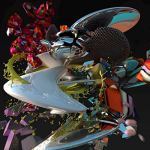 Lee Gamble
Lee Gamble
Exhaust (EP; digital & vinyl only)
Hyperdub (dist. Redeye)
SI-HDB-127
For a very different take on abstract electronic avant-pop, consider this, the second extended-play installment in what will eventually be a triptych of EPs making up a single work by Lee Gamble. The overarching project is called Flush Real Pharynx (a title of which Captain Beefheart would have been proud), and the first entry in the series was In a Paraventral Scale. This one features eight tracks of juddering, disorienting, but often hyperkinetically groovy electronic funk that draws on classic drill’n’bass, experimental electro, and other influences too numerous (and deconstructed) to identify. This would make a great addition to any library collection that supports curricula in modern compositional technique and/or contemporary pop music.
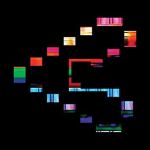 Squarepusher
Squarepusher
Be Up a Hello
Warp (dist. Redeye)
WARP309
Rick’s Pick
Thomas Jankinson, a.k.a. Squarepusher, is one of the architects of the drill’n’bass sound–a style that takes the funky double-speed breakbeats of jungle and cranks them up even further, making them faster and incorporating them into grooves that can be not only thrilling but also exhausting and sometimes claustrophobically intense. I’ve always admired his work but have never been able to listen to it for more than about 30 minutes at a time. So when I received a promo for his new album I downloaded it with a mixture of excitement and trepidation. To my surprise, though, it’s not only technically brilliant but also quite accessible. The beats are as fast and frenetic as ever and the arrangements just as dense and overwhelming, but there’s an undeniable sunniness and good humor to the music this time around. You may not choose this album as an accompaniment to reading a Russian novel or having a long conversation with a loved one, but for walking around downtown, tracks like “Speedcrank” and the frankly adorable “Hitsonu” are just the thing.
 Various Artists
Various Artists
Hastur (2 discs)
Cryo Chamber
CRYO 136
Written and performed by a collective of over 20 artists in the “dark ambient” tradition, this two-disc set is the final installment in a six-volume tribute to the venerated Gothic horror author H.P. Lovecraft. I recommend this release partly based on its intrinsic merits–the music is consistently outstanding, maintaining a delicate balance between quiet and unsettlingly intense–but also as a representative example of a subgenre of electronic music with which many are unfamiliar. Ambient music is usually assumed to be relaxing and pleasant, but dark ambient artists are more interested in exploring the ways that quiet and atmospheric music can set up complex and sometimes downright disturbing emotional and psychological environments. The Cryo Chamber label specializes in this kind of thing, and is well worth exploring.
 PAN-AL
PAN-AL
PAN-AL (EP; digital only)
Apollo (dist. Redeye)
AMB1908
We’ll round out our all-electronic Rock & Pop section this month with a very promising release from Norwegian artist Alexander Thorstvedt, who makes music under the name PAN-AL. His seven-track debut EP offers a blissful but bracing blend of soft atmospherics and sturdy, sometimes almost frantic beats, expertly balancing a mix of soft and hard sounds. Thorstvedt is hardly the first artist to experiment with this kind of musical emulsion, but his mix of ambient, jungle, and dreampop ingredients nevertheless comes across with quite a unique and personal feel. I love every track on this program, but I particularly enjoyed the Aphex Twin-esque “It’s Rigged” and the extra-dreamy “Just Open Up.”
WORLD/ETHNIC
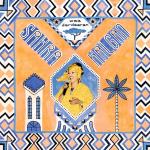 Sahra Halgan
Sahra Halgan
Waa Daradaran
Buda (dist. MVD)
0827160
On her second album, Somali singer and songwriter Sahra Halgan comes roaring out of the gate with a raggedly rocking small ensemble behind her and a voice that soars, warbles, and shouts. Those who love Ethiopian pop music will recognize some similarities here in the melodic shapes and the vocal techniques of Somali singing, but Halgan’s is a unique style; it draws not only on sounds and inflections of her home region, notably the very popular qaarami song form, but also on elements of rhythm and blues (“Caaqil”) and even British new wave (listen to that cheesy Farfisa organ on “Talo”). This isn’t “fusion” music, though; it’s organic and original and honestly eclectic while still providing a window on a musical culture too little known outside of Africa. Highly recommended to all libraries.
 LPT
LPT
Sin Parar (digital & vinyl only)
Self-released
No cat. no.
Rick’s Pick
When applied to pop music, the term “slick” is usually pejorative; it implies shallowness, pandering, inauthenticity. But it’s one of the best descriptors I can come up with for the debut album by LPT, an outstanding ten-piece salsa orchestra from Jacksonville, Florida, and I mean it in only the most positive way. The complexity of salsa music is such that unless your band is made up of seasoned professionals, it’s going to sound like a mess: your rhythm section has to be able to keep a complicated mathematical map in its head at all times, and your horns–of which you will need many–have to play together with absolutely airtight precision. And of course your singer had better have a rich, sweet singing voice and perfect intonation, or no one will even bother listening to the instrumentalists. LPT has all of those things and wields all of them with a winning combination of nimbleness and muscular strength. An altogether brilliant debut.
 Dengue Dengue Dengue
Dengue Dengue Dengue
Zenit & Nadir (digital & 2 LP only)
Enchufada
ENLP111
Billed as “the driving force in the rebirth of the South American digital cumbia scene” (try not to feel too bad if you weren’t already aware of the South American digital cumbia scene, or of its previous demise), Dengue Dengue Dengue have made several previous albums that blend various elements of Afro-Peruvian music with other traditions. But since the group’s move to Berlin, they have begun exploring more deeply the ways in which those traditions can be expanded by interaction with electronic dance elements. The results, as documented here, are wonderful: the music is hypnotic but varied, dense but nimble, regular but funky, old but new. I’ve listened to the album several times now, and I hear something new and exciting every time. Highly recommended to all libraries, though sadly it’s only available digitally and on LP–and the LP version would appear to be sold out already.
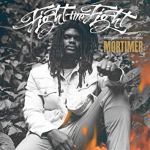 Mortimer
Mortimer
Fight the Fight (EP)
Easy Star/Overstand
ES-1077
This is a six-track EP from a very promising young reggae talent. Mortimer has made guest appearances on recent albums by Protoje and has released a couple of well-received singles, and this extended release should whet the marketplace’s appetite for a full-length album. Mortimer exemplifies the best of what’s happening in contemporary roots reggae right now: unafraid of incorporating elements of hip hop and R&B into the mix, he is nevertheless deeply grounded in the one-drop verities, and his lyrics are pretty strictly conscious. And he can do that singjay thing too, singing and chatting with equal felicity on the very rootsy and dubwise “Careful.” Great stuff.
 Busy Signal
Busy Signal
Parts of the Puzzle
VP
VP2503
Rick’s Pick
The relationship between reggae and American R&B has been deeply incestuous since the beginning–reggae emerged, in large part, as a Jamaican interpretation of the rhythms that were heard on Miami and Memphis radio stations in Kingston in the 1950s and 1960s. To see how that relationship continues today, look no further than the latest album from dancehall sensation Busy Signal, whose Parts of the Puzzle partakes deeply of such standard R&B tropes as smooth bedroom lyrics and the lavish and unapologetic application of AutoTune. Rhythmically, this album leaves reggae almost entirely aside in favor of the loping, stutter-step soca beat that has come to typify dancehall music in recent decades. Every song is smooth and beautifully crafted, and Busy Signal is a fine (if maybe a bit overproduced) singer. This is perfect driving music for a spring evening.